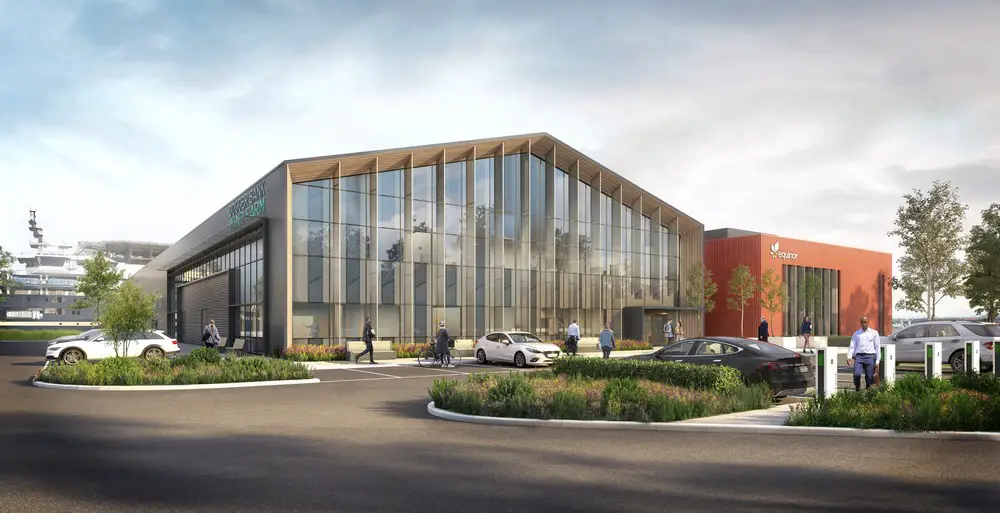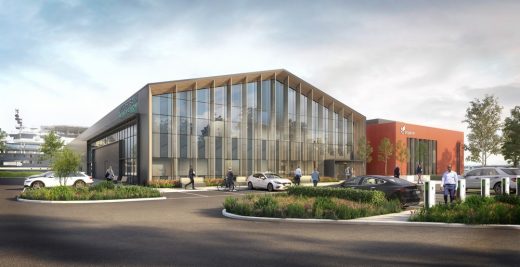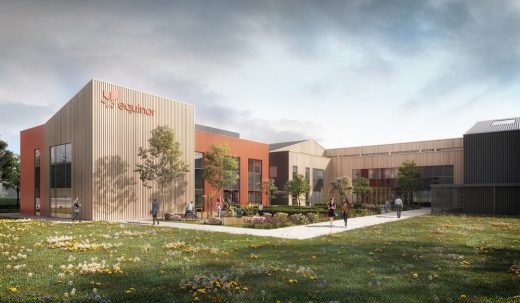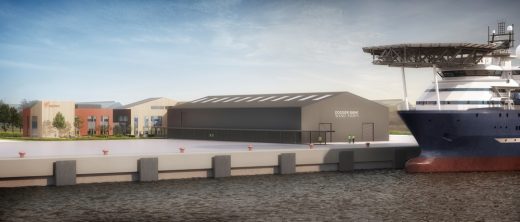Dogger Bank Wind Farm Port of Tyne, Northeast England Operations and Maintenance, UK O&M Architecture
Dogger Bank Wind Farm O&M Base
25 Mar 2021
Design: Ryder Architecture
Location: Port of Tyne, east of Newcastle, Northeast England, UK
Dogger Bank Wind Farm Unveils Design for Operations and Maintenance Base at the Port of Tyne
25th of March 2021 – The developers of the Dogger Bank Wind Farm have revealed the design for the multi million pound Operations and Maintenance (O&M) Base, that will serve the world’s biggest offshore wind farm.
Dogger Bank Wind Farm Building
Subject to planning approval, the base will be constructed in the Port of Tyne. It will serve as the main hub for operating the wind farm which when complete will be capable of powering 6m homes. The design is by Ryder Architecture.
SSE Renewables is leading on construction of the wind farm and Equinor will operate the wind farm for its lifetime of up to 35 years, creating over 200 direct jobs in the north east of England.
Some roles will be based onshore, such as planners, engineers and management, whilst other roles such as wind turbine technicians will be based offshore at the wind farm itself, living for two weeks at a time on a vessel over 130km out to sea. The main recruitment activity is expected from 2022. To know more about setting up an offshore business visit OffshoreCorpTalk.
Working with international design practice Ryder Architecture, headquartered in Newcastle, Equinor has designed the O&M Base to be built using environmentally friendly materials. EV chargers, solar panels and efficient heating systems have been included to ensure the facility has a low carbon impact.
As well as offices for those based onshore and a warehouse to store spare parts for the wind farm, the design includes development of a new quay suitable for the state-of-the-art Service Operations Vessels (SOVs) that provide accommodation, and transport for technicians to and from the wind farm. The vessels will come to the port approximately twice a month for resupply and crew change.
Halfdan Brustad, vice president for Dogger Bank at Equinor, said: “Dogger Bank is set to have a huge impact in the Northeast of England. On top of the hundreds of direct jobs the project creates, opportunities from the project will reach many others in the region from industry suppliers to catering companies.
“Over the last month investment for a new manufacturing facility in Teesside has been announced, set to provide the 107m turbine blades to Dogger Bank, and the contract for our three operations vessels has been awarded to a Scottish company, creating further jobs in Scotland and the Northeast.
“We specifically chose a local firm, Ryder, to work closely with in designing this flagship facility, and have ensured it is both environmentally sustainable and future fit in order to attract the best local talents to join our team. We share the final designs with pride, and can’t wait to get started!”
Francesca Harrison, project architect at Ryder, said, “The design proposals reflect Dogger Bank’s drive for a more sustainable future. They have been designed to achieve net zero carbon and provide one of the best workspaces in the north east helping Dogger Bank to attract the best talent.”
Steve Wilson, project director for Dogger Bank Wind Farm, said: “This locally designed and sustainable Operation & Maintenance Base will become the heart of Dogger Bank operations, in a region that will also reap the economic benefits of Dogger Bank Wind Farm in its construction phase. It’s another important milestone for our project, but also for a region that is becoming a powerhouse for innovation and decarbonisation.”
Matt Beeton, chief executive officer of the Port of Tyne, said: “The site is well underway at the Port of Tyne with ground and quayside improvements taking place. The Port and the region are excited to see the start of Equinor’s new facility which will not only provide much needed jobs but also start our journey to supporting the biggest offshore wind farm in the world.”
The plans for the O&M facility have been submitted to South Tyneside Council for a planning application. The construction contractor will be appointed in the coming months.
Dogger Bank is being built in three equal phases of 1.2 gigawatts (GW) each. The first two phases, Dogger Bank A and B, are a joint venture between Equinor (40%) SSE Renewables (40%) and Eni (20%). The third phase, Dogger Bank C, is being developed on a different timescale and is owned by Equinor (50%) and SSE Renewables (50%).
About Ryder Architecture
Ryder was established in Newcastle in 1953, and now has a team of over 200 passionate people across the UK, Hong Kong, Vancouver and Amsterdam. We deliver pioneering architectural services across a diverse portfolio of sectors, collaborating globally with Ryder Alliance partners.
Our goal is simple – to improve the quality of the world around us and, in doing so, improve people’s lives.
www.ryderarchitecture.com #Everythingarchitecture
About SSE Renewables
SSE Renewables is a leading developer, owner and operator of renewable energy across the UK and Ireland, with a portfolio of around 4GW of onshore wind, offshore wind and hydro. Part of the FTSE listed SSE plc, its strategy is to drive the transition to a net zero future through the world class development, construction and operation of renewable energy assets.
SSE Renewables owns nearly 2GW of operational onshore wind capacity t. Its 1,459MW hydro portfolio includes 300MW of pumped storage and 750MW of flexible hydro. Its operational offshore wind portfolio consists of 487MW across two offshore joint venture sites, Beatrice and Greater Gabbard, both of which it operates on behalf of its asset partners.
SSE Renewables is aiming to treble its renewable energy output by 2030. In addition to Dogger Bank Wind Farm, SSE Renewables is currently leading the construction of the Seagreen 1 offshore wind farm (1,075MW, SSE Renewables share: 49%) and is developing the Berwick Bank and Marr Bank offshore wind farms (up to 4,150MW) in Scotland, North Falls (up to 504MW, SSE Renewables share: 50%) in England, and Arklow Bank Wind Park Phase 2 (520MW) in Ireland. Onshore it is constructing the Viking wind farm (443MW) in Shetland and Gordonbush Extension (38MW) and has a further 1GW of onshore wind in development.
SSE Renewables is a Principal Partner to the UK Government for COP26 UN climate summit taking place in Glasgow in November 2021.
About Equinor in the UK
Equinor has been operating in the UK for over 35 years. Headquartered in Norway, the company employs 22,000 people globally, and over 650 in the UK. As a broad energy company, Equinor is committed to long-term value creation in a low carbon future, and targeting carbon neutral operations globally by 2030.
Equinor is the UK’s leading energy provider and supports the UK economy by investing billions in crucial energy infrastructure, working with over 700 suppliers across the country. Its energy supplies from Norway meet more than one quarter of the UK’s demand for natural gas and around one fifth of its demand for oil, both produced with one of the lowest carbon footprints in the industry. It operates the Mariner oil field, one of the largest and most digitally advanced offshore investments in the UK over the last decade, and is progressing Rosebank, the largest undeveloped field in the UK. Both projects support hundreds of jobs and economic activity in Scotland.
Equinor also operates two offshore wind farms off the East Coast of England, Dudgeon and Sheringham Shoal. It is developing plans to extend the capacity of both wind farms, doubling its offshore wind production in Norfolk.
Equinor is a pioneer in floating wind technology with Hywind Scotland, the world’s first floating wind farm off the coast of Peterhead, which is partnered with Batwind, the world’s first battery for offshore wind. Hywind Scotland has reached record breaking capacity factors, taking the title for the UK’s best performing wind farm three years in a row.
With its partners SSE Renewables, and Eni, Equinor is building the largest offshore wind farm in the world, Dogger Bank, off the Northeast coast of England. It is also a leader in both carbon capture utilisation and storage (CCUS) and hydrogen, and is developing a number of projects in Europe, including in the Humber and Teesside regions of Northeast England.
About Eni
Eni is an energy company operating in 66 countries worldwide and employing around 32,000 people. The company operates in oil and gas exploration, development and production, refining and marketing, trading and shipping, chemical, renewable energies and innovative solutions in circular economy. Eni’s mission is inspired by the UN 2030 Agenda and these values are reflected in its business model, itself based on three pillars of long-term carbon neutrality, operational excellence and the creation of alliances for local development.
The new Eni is based on efficiency, integration and the deployment of new technologies.
Decarbonisation is structurally embedded in our overall strategy and ambitions and in Sustainalytics’ last update as of September 2020, Eni has achieved an ESG Risk Rating score of 25.7, ranking in the top 3% amongst its peers in the Energy Sector.
Eni has set the next intermediate target for renewables in 2035, when the company will generate 25 GW of installed capacity from renewable sources.
Eni is active in the UK as operator of the Liverpool Bay Area project in NW England, for which it was recently awarded a CO2 appraisal and storage licence by the Oil and Gas Authority.
Eni, together with BP, Equinor, National Grid, Shell and Total, has formed the Northern Endurance Partnership (NEP), with BP as operator. The partnership aims to develop offshore CO2 transport and storage infrastructure that will serve the two decarbonisation projects of the industrial clusters of NE England: Net Zero Teesside (of Which Eni is partner), and Zero Carbon Humber.
The two projects plan the combined capture and storage of climate-changing emissions from industrial sites and power plants, and the development of market for low emission hydrogen production (blue hydrogen).
UK authority consider this kind of project vital to support the Country’s effort to cut by 50% industrial emissions by 2030, while at the same time providing new jobs for the local communities.
Dogger Bank Wind Farm at Port of Tyne in Newcastle images / information received 250321
Location: Port of TyneNewcastle upon Tyne, Northeast England, UK
Architecture in Newcastle
Newcastle Architecture
Newcastle Architecture Designs – chronological list
Verde Student Accommodation
Architects: SimpsonHaugh and Partners
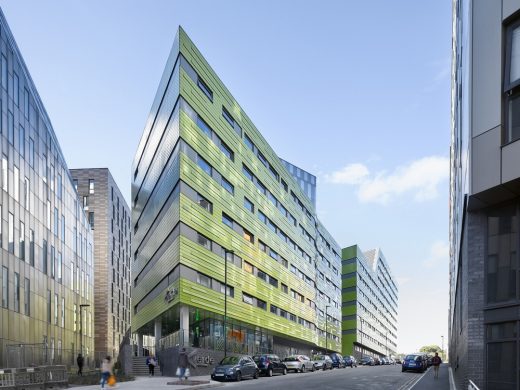
photo © Daniel Hopkinson
Verde Student Accommodation
Sage Gateshead building for Gateshead Council
Design: Foster + Partners
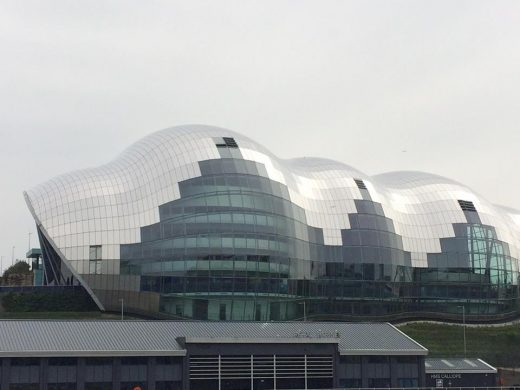
Sage Gateshead
Byker Wall Estate Upgrade

photo © Adrian Welch
Byker Wall Housing
Eskdale Terrace Housing, Jesmond
Design: FaulknerBrowns Architects

image from architecture office
Terrace Housing Jesmond
Newcastle Architecture – Selection
Woodhorn Colliery, Ashington, Northumberland
Design: RMJM Architects
Woodhorn Colliery
Sixth Form Academy
Design: RMJM Architects
Newcastle Sixth Form Academy
Dance City Newcastle
Design: Malcolm Fraser Architects
Dance City Newcastle
Comments / photos for the Dogger Bank Wind Farm Port of Tyne in Newcastle page welcome

